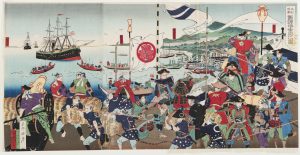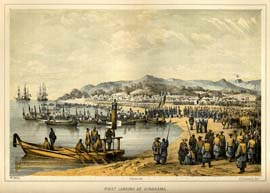The Black Ships Arrive!
Although 1854 marked the official opening of Japanese borders after a 200 year close to the outside world, Japan’s relationship with the West started much earlier. In 1635, the Tokugawa shogunate issued an edict to try to remove foreign influence from Japan. This period of isolation would last for over two hundred years but come to an end in 1853 when Commodore Matthew C. Perry would arrive in Japan. Perry was determined to sign a treaty and showed his determination through his very direct and strong actions. He refused to communicate with anyone but representatives of the Emperor, refused to move his ships, rejected gifts, and was very firm in his requests. After successfully giving letters regarding creating a friendship and suggesting a treaty, Perry left Japan, on his own terms of course. He returned to Tokyo Bay the next year in 1854 and was again firm in his actions, only wanting to create a treaty. In March of 1854, Perry was able to successfully negotiate for most of his demands and signed a treaty with the Japanese. Perry’s accomplishment marks the beginning of the doors of Japan opening to the world again.

Arrival of American Ships is a print made in 1889 by Toshu Shogetsu that depicted the arrival of American Commodore Matthew C. Perry in Japan. This print is intriguing because Perry’s arrival actually occurred in 1853, a whole 36 years earlier. It is a sort of display of wishful thinking, where the artist placed emphasis on the readiness of the Japanese, led by the Tokugawa, and the capabilities of the shogunate in welcoming the West. The Tokugawa flag is being raised high, cannons are being prepared, and commoners and samurai are combining their efforts to increase readiness.
The Japanese look heroic and the samurai class looks powerful and threatening, whereas the American ships appear rather commonplace. There is even a small fleet of Japanese boats being sent out to meet the ships. This print raises the question: what was the artist thinking while making this print so long after the initial arrival of the West and modernization? Could it be regret, a statement on what the artist wished would have happened? Is it pride, an extremely optimistic retrospect on the way the West actually was welcomed? Regardless, the 36-year gap between the arrival of the Americans and the creation of this print had brought countless changes to Japan, and the Japanese relationship with the West had truly been changed forever.

It is important to note that the initial Japanese response to the arrival of the Black Ships was quite different. The artwork American Warship is a woodblock print created in 1854 by an unknown artist. Created only a year after Perry arrived in Japan, the artist depicts an angry view of the American vessels entering Japan. The ship brings about an evil presence, especially with the demonic face at the front of the ship. This may be a way for the artist to portray to Japanese citizens that the arrival of the Americans is not something to be welcomed, but rather something negative and threatening that should be stopped. This is in contrast with the Arrival of American Ships created by Toshu Shogetsu, in which Shogetsu creates a more straightforward and realistic depiction of the American ships. it portrays an impressive and very large ship especially compared to the ships of the Japanese. It is also interesting to note that Shogetsu created this art in 1889, more than thirty years after the American Warship was created. The different depictions of the black ships may hint at the varying motives of both artists. The first piece of work was created at the time Perry had been trying to make Japan leave its period of isolation, perhaps angering the Japanese people who didn’t want change. However, thirty years later, after seeing the end result of the Americans arriving in Japan, Shogetsu is able to create a piece of art depicting the ships in a more realistic light and putting the focus back on the Japanese.

The First Landing at Gorahama is a painting by an American artist, Wilhelm Joseph Heine, that depicts the same scene as the Japanese painting by Shogetsu but has stark differences. The two paintings evoke distinctive emotions and have unique points of view. The use of muted colors in the American painting contrasts with the use of bold colors, such as bright red, in the Japanese work. This shows that the Americans viewed their interactions with the Japanese as a calm negotiation rather than a potential battle, as depicted in the Japanese painting. Heine chose to depict the negotiations after the arrival of the Americans to the Japanese coast, while Shogetsu chose to depict the scene just prior to the arrival of the American ships. The Japanese painting depicts what looks like a preparation for battle rather than a negotiation, revealing that the Japanese wanted history to show that they were not the weaker people, but rather were well equipped to defend themselves against the Americans, if needed. In contrast, in the American painting, the Japanese people are depicted as standing at the coast, waiting for the arrival of the Westerners and open to negotiating with them. The Japanese ships shown in the American painting are also smaller and less well-built when compared to the Japanese ships shown in Shogetsu’s work. Another interesting note is the American depiction also includes the American flag, but does not feature a Japanese flag, while the Japanese depiction shows the Tokugawa flag and not the American flag. Perhaps showing the contrasting points of view that the paintings were trying to portray.
Arrival of American Ships is an important retrospective print that depicted what was arguably one of the most important events of Japanese Westernization. Not long after Perry’s successful efforts to open Japan to the West, the Tokugawa shogunate, which had been in power since 1600, ended in 1868 with a coup by what would become the new Meiji government. The Iwakura Mission was sent overseas to broaden horizons and connect Japan with the rest of the world. Japanese students were sent to Europe and the United States to learn. Modernizing taxation and trade policies led to depression in the early 1880s. Western inventions and customs further made their way to Japan, and buildings, banking, education, means of travel, healthcare, and art all saw extreme Westernization. Constitutional government arrived in Japan and caused the implementation of a constitution and legislative government. By 1889, Japan was a completely different country than it was in 1853, when Perry’s black ships arrived off the Japanese coast. The artist of this print portrayed not only the arrival of Perry, but the official marker of change to Japanese society.
References:
“Brief Summary of the Perry Expedition to Japan, 1853.” Naval History and Heritage Command, 23 Aug. 2017, www.history.navy.mil/research/library/online-reading-room/title-listalphabetically/b/brie -summary-perry-expedition-japan-1853.html.
Huffman, James. “The Meiji Restoration Era, 1868-1889.” Japan Society, 2020, aboutjapan.japansociety.org/the_meiji_restoration_era_1868-1889#sthash.QNumDyfy.Oau8hiq.dpbs.
Aishwarya Sridhar (’21), Stephanie Loy (’22), and Izzy Bonvini (’23)